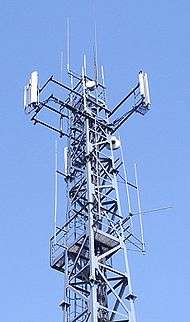Cell Broadcast

Cell Broadcast/Cell Information (CB) messaging is a mobile technology feature defined by the ETSI’s GSM committee and is part of the GSM standard. It is also known as Short Message Service-Cell Broadcast. (SMS-CB).
Cell Broadcast is designed for simultaneous delivery to multiple users in a specified area. Whereas the Short Message Service-Point to Point (SMS-PP) is a one-to-one and one-to-a-few service (requires multiple SMS messages, as each message can only carry one phone number), Cell Broadcast is a one-to-many geographically focused messaging service. Cell Broadcast messaging is also supported by UMTS.
Cell Broadcast messaging was technologically demonstrated in Paris for the first time in 1997. Some mobile operators use Cell Broadcast for communicating the area code of the antenna cell to the mobile user (via channel 050), for nationwide or citywide alerting, weather reports, mass messaging, location-based news, etc. Not all operators have the Cell Broadcast messaging function activated in their network yet, and many handsets do not have the capability to support cell broadcast.
Cell Broadcast is a technology that allows a text or binary message to be defined and distributed to all mobile terminals connected to a set of cells. Whereas SMS messages are sent point-to-point, Cell Broadcast messages are sent point-to-area.
Thus, one Cell Broadcast message can reach a huge number of terminals[lower-alpha 1] at once. In other words, Cell Broadcast messages are directed to radio cells, rather than to a specific terminal. A Cell Broadcast message is an unconfirmed push service, meaning that the originator of the message does not know who has received the message, allowing for services based on anonymity. Mobile telephone user manuals describe how the user can switch the receiving of Cell Broadcast messages on or off.
Cell Broadcast is not as affected by traffic load; therefore, it may be usable during a disaster when load spikes (mass call events) tend to crash networks, as the 7 July 2005 London bombings showed. Another example was during the Tsunami catastrophe in Asia. Dialog GSM, an operator in Sri Lanka was able to provide ongoing emergency information to its subscribers, to warn of incoming waves, to give news updates, to direct people to supply and distribution centres, and even to arrange donation collections using Celltick's Cell Broadcast Center, based on Cell Broadcast Technology.
Cell broadcast has been widely deployed since 2008. The major European operators have deployed the technology in their networks. In Pakistan, Telenor PK was the first network to use this option country wide. Telenor Pakistan provides location indicator service branded as Auto Location. WaridTel also uses this option but it is not nationwide and displays offers only.
Cell Broadcast is a mobile technology that allows messages (up to 15 pages of up to 93 characters) to be broadcast to all mobile handsets and similar devices within a designated geographical area. The broadcast range can be varied, from a single cell to the entire network.
Technology
A Cell Broadcast message page is composed of 82 octets, which, using the default character set, can encode 93 characters. Up to 15 of these pages may be concatenated to form a Cell Broadcast message. Each page of such a CB message will have the same message identifier (indicating the source of the message), and the same serial number. Using this information, the mobile telephone is able to identify and ignore broadcasts of already received messages.
A Cell Broadcast Centre (CBC), a node which is a source of SMS-CB, is connected to a base station controller (BSC) in GSM networks or to a radio network controller (RNC) in UMTS networks via standardized interface over TCP/IP. The BSC-CBC interface is described in 3GPP standard TS 48.049; however, non-standard implementations exist. The RNC-CBC interface is described in 3GPP standard TS 25.419. A CBC sends SMS-CB messages, a list of cells where messages are to be broadcast, and the requested repetition rate and number of times they shall be broadcast to the BSC/RNC. The BSC's and RNC's responsibility is to deliver the SMS-CB messages to the base station (BTSs) and NodeBs, which handle the requested cells.
In GSM SMS-CB messages are broadcast over an air interface on a special signaling channel, Cell Broadcast Channel (CBCH). CBCH reuses one of signalling channels (SDCCH). There is only one CBCH in each cell in cellular network. GSM specification allows to send only one SMS-CB message page every 1.883 s in basic mode and another one in extended mode. However extended mode is optional in GSM thus neither networks nor mobile phones are required to support it, so the real throughput is only one message page each 1.883 s in basic mode.
Broadcast messages are used in the United States to send emergency alerts, using the Commercial Mobile Alert System C-interface protocol, which has been specified jointly by the Alliance for Telecommunications Industry Solutions and the Telecommunications Industry Association. All four major providers have agreed to take part.
See also
Footnotes
- ↑ A "terminal" in this context is a "mobile " or any device (usually a mobile telephone) which can receive voice or data via the GSM/UMTS network.
External links
| Wikimedia Commons has media related to GSM Standard. |
- 3GPP - The current standardization body for GSM with free standards available
- 3GPP TS 23.041 Technical realization of Cell Broadcast Service (CBS)
- 3GPP TS 25.419 UTRAN Iu-BC interface: Service Area Broadcast Protocol (SABP)
- 3GPP TS 44.012 Short Message Service Cell Broadcast (SMSCB) support on the mobile radio interface
- 3GPP TS 45.002 Multiplexing and multiple access on the radio path
- 3GPP TS 48.049 BSC-CBC interface specification; Cell Broadcast Service Protocol (CBSP)